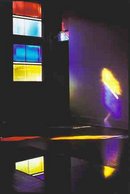Leadline 1994: Colour and Light: Image and Emanation (Part Three)
 by Jason Peter Brown on July 23, 2007
by Jason Peter Brown on July 23, 2007
 Filed Under: REPRINTINGS, LEADLINE, STAINED GLASS, ART
Filed Under: REPRINTINGS, LEADLINE, STAINED GLASS, ART
This editorial was written by Doreen Balabanoff, and originally appeared in Leadline in 1994. Part three of six. You can read Part One here.
But an electric sign, same voltages not-withstanding, cannot come close to the illuminated image of which stained glass is capable. It has none of the material qualities of glass; nor, being artificially lit, does it have the chance to respond to the 'breathing' or the movement of natural light. Illuminated signage has no capacity, as glass does, to mediate between two worlds (inside and out), nor to project light into space and onto form. And cinema and video, though related in luminosity, most often use light and colour as vehicles for a visual/mental experience, not as direct sensory experiences in themselves. It is the physicality of coloured light itself which stained glass brings to our attention.
But if "light-through" had been reduced to a narrowed range of experience by opaque German architectural work, the graphic reproduction of that work had gained something in the process. The power of the media to shape opinion and form impressions is well known, and stained glass is highly susceptible to the limitations imposed by the printed image. German 'graphic' work was emulated around the globe - partly because of the ease of reproducing it as a strong graphic image.
Those who attempt to represent stained glass in the printed media are constantly struggling with the inadequacy of photographic and printing processes in the face of the physicality of a coloured window. These problems of reproduction are worth a few moments of attention here, as they impact directly upon one's ability to discuss the medium in publications, coloured or not.
The visual image presented to our eyes by a naturally lit stained glass window (in situ) is not a static one; it changes constantly with variations of light a movement of the viewer. If transparent, it must 'live with' the 'landscape' beyond it. At best, it is difficult to represent adequately by means of a still photograph. This is true, whether the work is small or large in scale, architectural or not; but works which are built into architecture pose the most difficulties, as a camera rarely does justice to spatial properties, and can never capture simultaneously how the window and the space appear to the human eye. If the space, for example, appears true to life, the window will be bleached; and if the window is shown accurately, the space will be much darkened. At a recent glass conference, New York artist Sydney Cash used video to show his kinetically optical sculptural works - a clever and logical step towards addressing the 'static image' problems of documentation. Yet video is not very useful for representing glass in architecture, due to its very limited colour/value range.
For similar reasons, the stained glass artist's use of colour is difficult to demonstrate via the printed image. Apparent changes of colour, for example, caused by what is visible beyond a transparent window, can become dominant compositional elements in a photograph, but are 'read' by the eye quite differently when one is standing before the actual window. The subtleties of various kinds of glasses and their variability in different light conditions are also not possible to portray in print.
